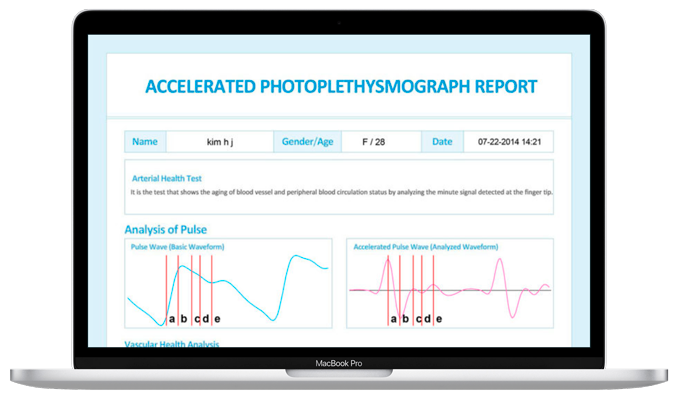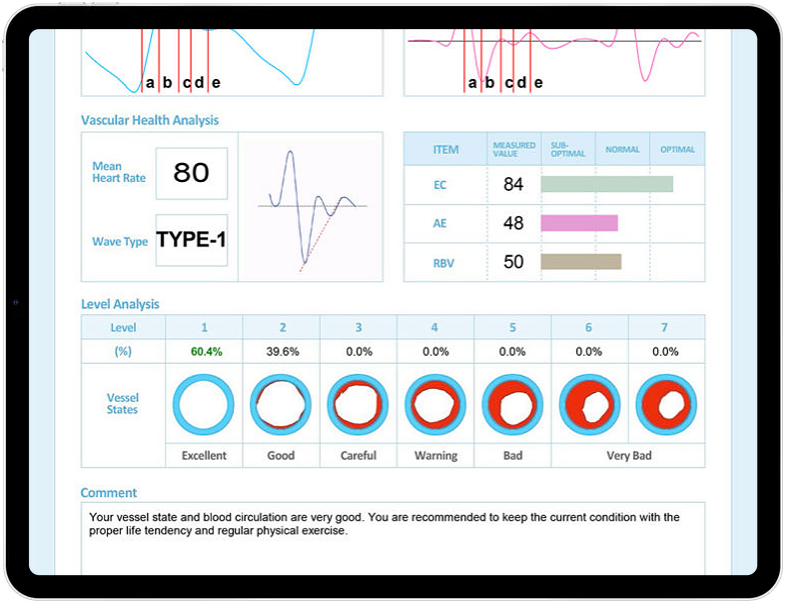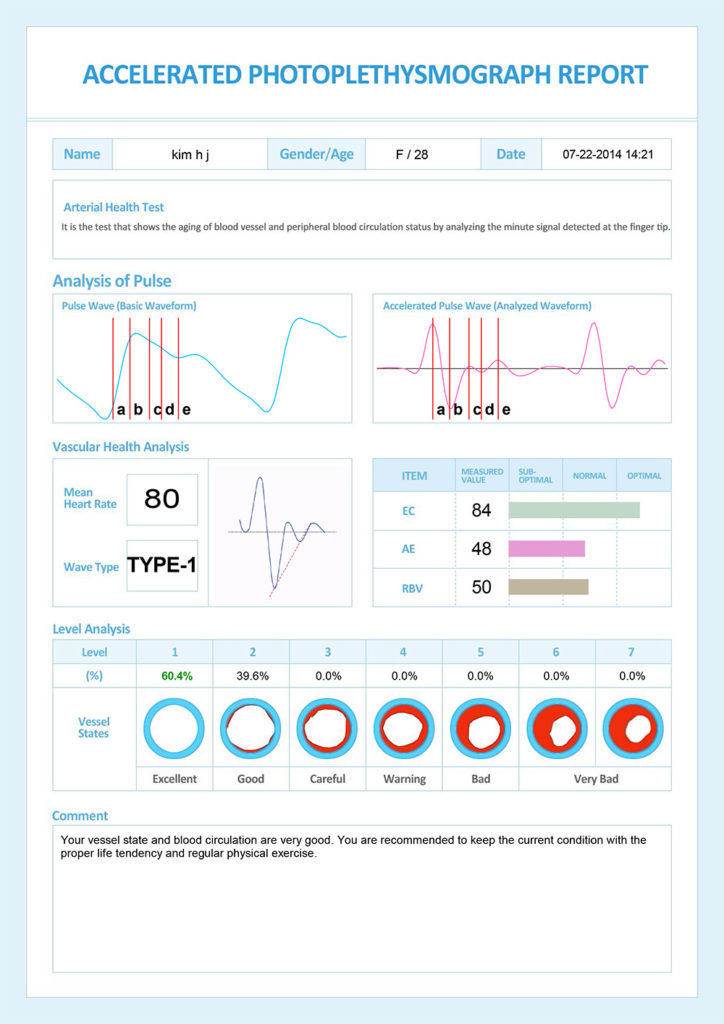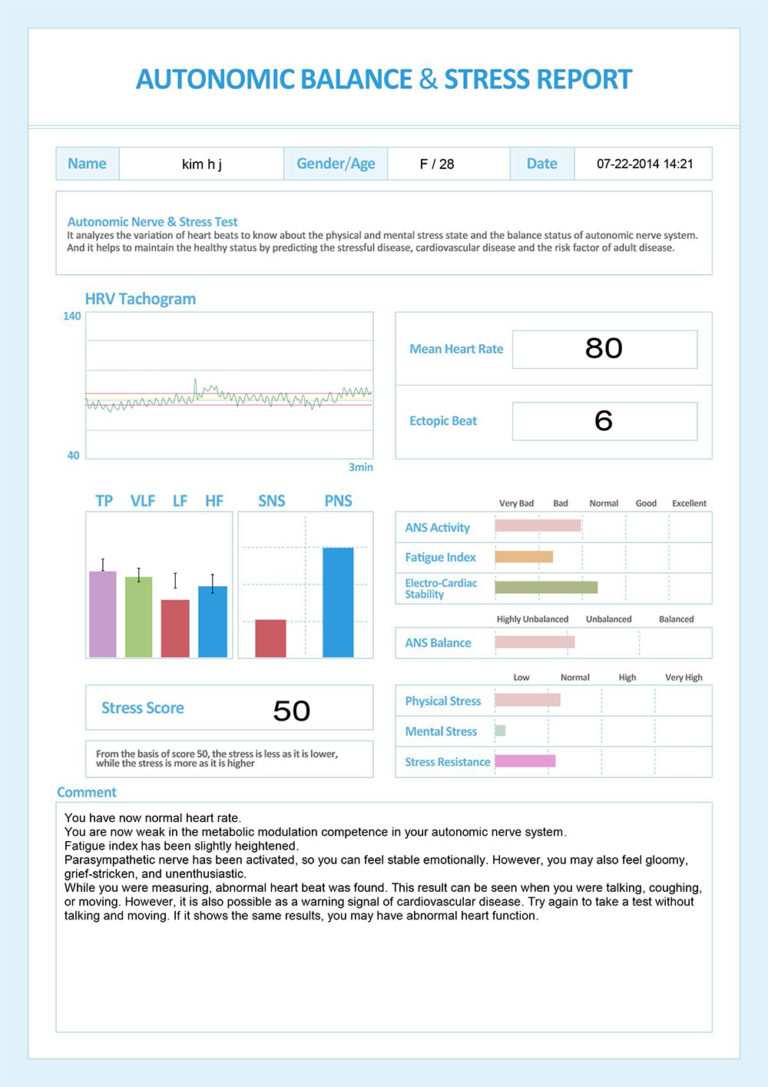Max Pulse Reports
Max Pulse Device
The Max Pulse is a non-invasive, FDA Cleared, Class II medical device that uses a pulse oximeter to detect and interpret the arterial pulse wave using a proprietary algorithm.
This pulse wave analysis provides vital information which is then displayed on easy-to-interpret results sheets which show a patient’s arterial flexibility and autonomic nervous system state.

Max Pulse Arterial Health Report
Please note that after purchase you will have access to a 20 page long, very detailed quick start manual that covers every aspect of using the Max Pulse and also understanding and interpreting the test.
After you have run the test, click PRINT and you will generate a final report that can either be printed or saved to PDF.
Analysis of Pulse Section: Here you can see the arterial pulse wave. As arterial health declines, the dicrotic notch slowly disappears. Mean Heart Rate – Average Heart Rate during the test. (The result is shown after the 1 minute and the 3 minute test.) Wave Type: This shows the overall arterial health of the patient, by displaying the most dominant arterial wave type during the test.
Level Analysis Section: As the test runs, each heartbeat is evaluated as to which of the 7 types it falls into. At the end of the test, this information is presented in this grid. Levels 1-7 are depicted, and underneath each level is shown the percentage of heartbeats that fell into each category. Often heartbeats will fall across two adjacent levels. For example a very healthy person might show 80% in Level 1 and 20% in Level 2.
EC: Eccentric Constriction: It represents the contraction power of vessels from the left ventricle.
AE: Artery Elasticity: This represents the blood circulation that is analyzed as well as the vascular elasticity and the resistance of the vessels.
RBV: Remaining Blood Volume: Represents the remaining blood in the vessels after systolic contraction of the heart.
Note that arterial deterioration has 2 progressions:
Dominantly Arterial Hardening 1 -> 2 – > 4 -> 6 -> 7
Dominantly Heart Weakening 1 -> 2 -> 3 -> 5 -> 7
This progression was seen in the original research on the device. As such types 3 and 5 will be seen more rarely, but are cause for more concern.
Note: The graphics on the report are generic and do not reflect any measurement by the device
FDA Cleared, Class II Medical Device
The Max Pulse is a non-invasive, FDA Cleared, Class II medical device that uses a pulse oximeter to detect and interpret the arterial pulse wave using a proprietary algorithm.
This pulse wave analysis provides vital information which is then displayed on easy-to-interpret results sheets which show a patient’s arterial flexibility and autonomic nervous system state.
Call now (210) 610 2521 and order your Max Pulse

Boost your quality of care
Max Pulse ANS Health Report
The HRV tachogram shows each heartbeat during the test period. To the right you will see mean heart rate and the number of ectopic beats.
TP LVF LF HF Section (Total Power / Very Low Frequency / Low Frequency / High Frequency). Power in 4 frequency bands are analyzed: Total Power / Very Low Frequency / Low Frequency / High Frequency. See page 15 for more detailed information.
SNS/PNS Bar Graphs show the SNS/PNS Balance – SNS (sympathetic nervous system) & PNS (parasympathetic). SNS and PNS ratio is normal at around 6:4. Higher SNS can show up as nervous, anxiety, agitation, excitement, increasing blood pressure, headache, etc.
The total stress score on a scale of 1 to 100, where 1 is zero stress and perfect autonomic nervous system function and 100 is the worst level of stress and imbalance. 50 is considered normal.
The Mean Heart Rate show the average heart rate over the 3 minute test.
The Ectopic Beat is the number of ectopic beats recorded during the test. Note that if the patient is moving around or talking, the device may register beats as ectopic incorrectly.
ANS Activity, Fatigue Index and Electro-Cardiac Stability. The bar charts will show if the patient is in normal ranges for overall ANS performance, level of Fatigue and Stability of heart.
The ANS Balance is an easy-to-interpret bar chart representation of the SNS/PNS bar graphs just to the left. Also bars for physical and mental stress are included. Stress Resistance is how well the patient deals with stress.
The Comment Section is a computer generated assessment of the patient.
Doctors Are Lovin' It
The Max Pulse provides a three-minute test to detect arterial hardening and stress levels. It’s non-invasive and uses a photoelectric clip on the fingertip.








